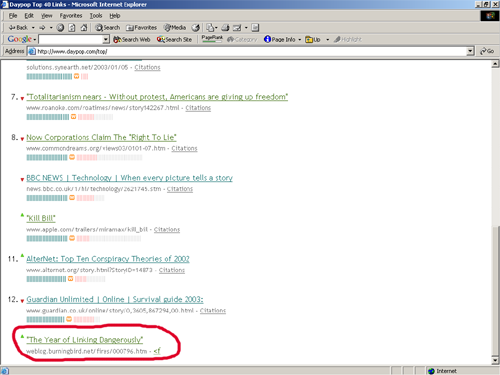Recovered from the Wayback Machine.
I feel it it my bones: 2003 will be the Year of Linking Dangerously. It will be the year that we reject page ranks and popularity-based ‘s/he with the most links bubbles to the top of the heap’ skimmers.
It’s in the air. It’s viral. It’s contagious. Hold your breath or you’ll catch it.
Case in point: Joshua Allan writes elegantly and compellingly in defense of the Semantic Web in response to somewhat disparaging comments made by Mark Pilgrim and Dare Obasanjo. In his post, Joshua makes the point that the Semantic Web is about people, and about making people’s voices audible and indelible.
On audibility, Joshua writes:
Today I get most of my lies from whichever barbarians have clawed their way to the top of the local and national media outlets. But sometimes when I see an advertisement for an interesting new product, I want to be able to pick up my remote control and click on “connect me to five people who hate the product and ask them why”
On indelibility, Joshua continues:
The story of Babel is a metaphor for what later happened at Alexandria; a reminder that we all suffer when we lose our ability to pass lessons to future generations…
Again, the Internet has had a profound impact on our ability to preserve our collective memory, but we are still very fragile.
Joshua sees the Semantic Web as a way of storing our collective knowledge in a manner that is easily accessible, based on methods more effective than today’s crude raw scans of hypermarked text. He also sees that the so-called problem child of the Semantic Web, RDF/XML, is more of a “red-herring” to the discussion rather than an actual impediment. RDF/XML is really nothing more than the selected method used to record knowledge, chosen from among all possible methods. It’s a means to an end, not the end itself. He answers the argument about RDF/XML being too complicated by saying:
The primary serialization for RDF is XML. This really starts to hurt your brain when you realize that RDF and XML are almost the same thing. Too much meta and your mind can’t bootstrap.
Joshua also states that he agrees with the consensus that, overall, RDF is to complex for most renmin (“people”), something I, of course, <shamelessplug>hope to disprove with my book</shamelessplug>.
Joshua Allan’s post is extremely well written and well argued, and you should take time to read it in its entirety — whether you’re a techie or not. I not only agree completely with Joshua, I’ll take it farther by saying that the Semantic Web will never be built with today’s system of dumb links — links with no inherent meaning attached to them other than their numeric value. All links do is push a resource’s rank up, piling link after link like pieces of wood for a bon fire; except instead of using dead trees we’re using dead links.
Torch the piles! Reject the concept of “all we need is links, sweet links”! Burn down the house that Google built before we become as dependent on Google as we almost became on Microsoft Windows.
So where do you start?
First, enable Trackback. It’s the first semi-intelligent threading implementation that’s actually starting to get fairly widespread use.
The Trotts from Movable Type have provided standalone trackback servers for those who don’t use Movable Type. The technology has already been integrated into Bloxson. If you’re using a weblogging tool that hosts the pages, ask the tool vendor to incorporate trackback functionality if it hasn’t already.
Once your tool supports Trackback, use it. It’s there to allow people to visibly show their connection to your writing. It let’s your readers know that others have something to say about your post, good or bad. It continues the conversation. It breaks the hell out of this idea that weblogs are just some form of electronic journal, written in isolation that just happens to be published for posterity’s sake.
More than that, though, Trackbacks provide deliberation and some intelligence with the link. Not a whole lot other than the words of the associated post, but it’s a start. There’s a tiny bit of RDF/XML associated with the Trackback link — a placeholder for future information, future bits of knowledge. A base on which to build.
At a minimum, Trackback doesn’t break into your space like comments does. You don’t even have to post the excerpts associated with the trackback — just the link. By allowing trackbacks, you’re providing a way for others to participate in the thread you started. When you don’t implement trackback, you’re breaking the thread.
Of course, the use of Trackback, as well as enabling comments is a personal choice. If you wish to separate yourself from others and exist in splendid isolation, far be it from me to get in your face about it.
Next week, part two of Year of Linking Dangerously — getting rid of your blogrolls.
(Thanks to Kevin Marks for sending me the link to Joshua Allan’s wonderful post.)

